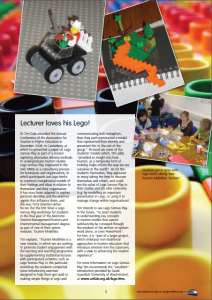Dr Tim Gale, Senior Lecturer in Tourism Management Head of Education and Professional Practice, Department of Tourism and Hospitality Faculty of Management,tells us below about Lego Serious Play:
For some time now I have been using Lego Serious Play to facilitate discussion in class (sparingly, as you can have too much of a good thing), as demonstrated by the attached extract from an old Department of Geography and Environmental Management newsletter at UWE- my previous institution. Using Lego bricks, elements and minifigures, I invite students to produce metaphorical models to depict things that cannot be adequately conveyed by the written or spoken word alone, or the ubiquitous PowerPoint presentation. I’ve used this with first year undergraduates, doctoral students and just about everyone in-between, to explore such things as personal identities and how tourism and mobility informs the way we see ourselves in the world, what life might be like in 2050 (futures studies), and experiences of studying for a higher degree (achievements, dissapointments, hopes and fears, etc). Talking to a prop can help to overcome students’ in-built reluctance to volunteer information, instilling a confidence that is often lacking in more traditional presentations. There is also scope to work collaboratively with peers on shared models- good for social bonding, as well as learning. It doesn’t work for everyone and in every setting, but the feedback has generally been positive with most students enjoying the opportunity to be creative and think ‘outside the box’.
Regardless of whether it involves playing (seriously) with Lego or something else, I believe that emotion has a place in the classroom. What do you think? Any examples from your own practice to share?
For further information on the LSP methodology, see David Gauntlett’s (formerly of BU, now at the University of Westminster) excellent website and publications:
- www.artlab.org.uk/lego
- Gauntlett, D. and Holzwart, P. (2006) Creative and visual methods for exploring identities. Visual Studies, 21(1), 82-91
- Gauntlett, D. (2007) Creative Explorations: New Approaches to Identities and Audiences. London: Routledge.
PS. I have a large quantity of Lego in my office (D126), should colleagues wish to use LSP with their students!








I use Duplo in one of my seminars where the simple task is to build a wall against a specific specification. This is done in small groups. However each student is given their own copy of instructions and in each set is a slightly different requirement that only they are to know about. We then discuss communication, group work, shared tasks and conflict within groups.
Such a simple task that really gets them engaged and I sometimes have a prize for the most pleasing wall?!
I was very interested to read about Lego Serious Play. I have recently used Lego with first year Physiotherapy students. The Lego was used to facilitate them to do a SWOT analysis based on a one week orientation placement that they had recently attended. They were invited to work in groups and to produce a model to illustrate the Strengths, Weaknesses, Opportunities and Threats of the placement. They were then asked to talk about the model they produced and how it related to the placement experience. As Tim Gale mentioned talking to the model helped to overcome some of the students’ inhibitions in talking about their learning on placement. The students seemed to enjoy the activity which formed the basis for them to then individually reflect on the learning opportunities they had in placement and formulate their action plans.
In Physiotherapy so much of the learning happens on placement and our skill is to facilitate the students to be able to reflect on their learning as a means to improving their future practice. My initial experience of using the Lego for a placement debriefing session was successful and enabled the students to reflect in depth on the placement and what they had learnt. There was also a depth of insights into the processes of learning how to become a competent Physiotherapist.
I plan to use the Lego again so will let you know how I get on next time.
Tim, many thanks for the references as I am writing this as a case for my HEA application
I’d be very interested to hear if there are any more examples of how Lego can be used and I too have a large quantity in the office!